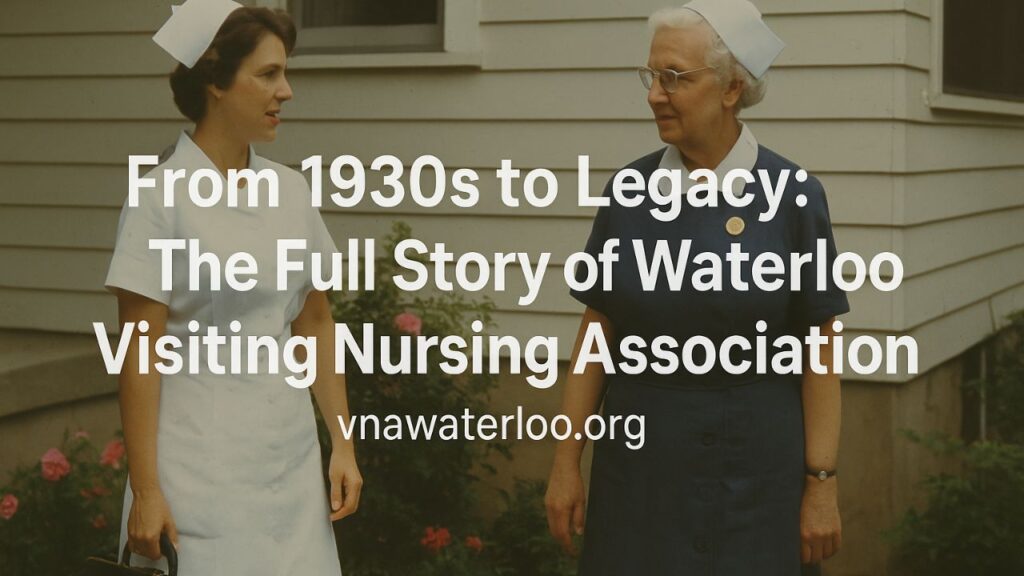From 1930s to Legacy – The Waterloo Visiting Nursing Association (WVNA) has stood as a pillar of home health care and compassionate nursing in Ontario for nearly a century. Founded in the 1930s, this community-driven organization began as a humble initiative to provide accessible nursing care to individuals in their homes. Today, it is remembered as a symbol of public health advancement and patient-centered support that transformed how Canadians received care outside hospital settings. With the goal of reducing institutionalization and promoting wellness at home, WVNA touched thousands of lives with its personalized, in-home services.
At a time when hospitals were overcrowded and public health services were minimal, the WVNA pioneered an innovative model—bringing skilled nurses directly to the doorstep of the ill, elderly, disabled, and recovering patients. Over the decades, it expanded its services beyond basic medical care, offering health education, chronic disease management, rehabilitation, and emotional support. This shift mirrored changing health care needs and evolving community demographics, allowing WVNA to remain relevant through generations.
Throughout its journey, the WVNA remained dedicated to nurturing independence, dignity, and quality of life. It worked in close partnership with hospitals, physicians, social service providers, and community leaders to develop an integrated care ecosystem. As health care systems became more modernized and centralized in the 2000s, many community-based nursing services like WVNA began to transition or integrate with broader regional health authorities. Yet, the legacy of WVNA continues to live on through the impact it left behind, and the stories of the individuals and families it served.
The story of WVNA is not just about health care—it’s about human connection, dignity, and the belief that healing is most effective when it happens in the comfort of home.
 Over 90 Years of Compassionate Home Healthcare: How Waterloo VNA Served Generations of Iowans
Over 90 Years of Compassionate Home Healthcare: How Waterloo VNA Served Generations of Iowans
Origins and Mission of Waterloo Visiting Nursing Association
WVNA was built around a core mission: to provide skilled, compassionate, and accessible nursing services directly to homes in the Waterloo region.
- Established in the early 1930s as a response to rising public health needs
- Initially staffed by a small team of community nurses
- Focused on supporting families without access to hospitals or clinics
- Aimed to reduce unnecessary hospitalization
- Served a broad demographic: elderly, chronically ill, disabled, and new mothers
- Funded through local fundraising, grants, and public health partnerships
- Operated with a focus on preventative care and home wellness
Early Growth and Community Response
In its formative years, WVNA saw rapid expansion as demand for home-based care grew across Ontario.
- Worked closely with municipal health departments
- Recruited trained nurses and volunteers for field service
- Introduced early maternal and child health programs
- Provided TB care, post-surgical recovery, and wound management
- Fostered deep trust within communities for reliable health support
- Received support from churches, women’s leagues, and local councils
Evolution of Services: 1950s to 1990s
As medicine advanced and community needs changed, WVNA adapted its services and infrastructure to meet new challenges.
- Expanded home care to include chronic illness and palliative support
- Created diabetes management, stroke recovery, and physiotherapy plans
- Implemented tele-nursing services for remote health monitoring
- Partnered with local hospitals for discharge follow-up care
- Introduced caregiver training for family members
- Delivered flu immunizations and health checkups at homes
- Advocated for equitable access to care in rural zones
Program Timeline of Key Service Expansions
| Year | Program/Service Introduced | Focus Area | Notes |
|---|---|---|---|
| 1952 | Post-Surgery Home Recovery | Surgical discharge patients | Reduced hospital readmissions |
| 1961 | Maternal and Infant Home Support | New mothers and infants | Breastfeeding help, postnatal visits |
| 1978 | Chronic Disease Management | Diabetes, hypertension, asthma | Regular monitoring and medication support |
| 1986 | Hospice-at-Home Services | Terminal illness support | Palliative comfort and counseling |
| 1992 | Health Education and Workshops | Community health awareness | Fall prevention, nutrition, self-care |
| 1998 | Telecare Nursing | Remote patient monitoring | Enabled phone support for isolated seniors |
| 2003 | Senior Wellness Checks | Elderly preventive visits | Identified risks early, reduced ER visits |
Strategic Partnerships and Regional Integration
WVNA collaborated with numerous institutions to build a holistic care ecosystem that reached every corner of Waterloo.
- Affiliated with Grand River Hospital and St. Mary’s General Hospital
- Worked with local physicians for continuous care
- Coordinated with municipal health departments
- Participated in Waterloo-Wellington LHIN initiatives
- Developed referral systems with social work and mental health units
- Shared training programs with nursing colleges
- Advocated in provincial forums for home care policy reforms
Community Collaboration in Action
The value of WVNA’s outreach and integration was seen in multiple cross-agency efforts.
- Joint diabetes management program with dietitians
- Fall-prevention program led by physiotherapists and nurses
- Collaborative case reviews with family doctors
- Participation in regional disaster and epidemic response planning
Impact on Families and Homebound Individuals
The Waterloo Visiting Nursing Association impacted thousands of families by making health care accessible, personal, and dignified.
- Helped aging individuals live independently longer
- Offered peace of mind to families unable to care for loved ones full-time
- Empowered patients through health education and self-management
- Served multicultural communities with respect and cultural sensitivity
- Provided continuity of care through consistent nurse-patient relationships
- Alleviated the financial burden of repeated hospital visits
- Created lasting emotional bonds with families over years of service
Testimonial Highlights
| Patient/Family Name | Year Received Service | Testimonial Summary |
|---|---|---|
| Mrs. Hannah L. | 1975–1983 | “The nurses became like family. They gave me my life back.” |
| Smith Family | 1980–1990 | “We trusted WVNA more than any hospital.” |
| Tom K. | 1997–1998 | “After my stroke, they helped me learn to walk again—at home.” |
| Meena P. | 1995–2002 | “They respected our traditions while caring for my father.” |
| Allen Family | 2000–2006 | “Without WVNA, mom would have been in a home. Instead, she passed peacefully with us.” |
Final Years and Lasting Legacy
With the growing centralization of Ontario’s health care system in the 2000s, many regional home care programs, including WVNA, were absorbed into larger administrative bodies.
- WVNA officially merged into a regional health network post-2010
- Services continued under broader umbrellas like LHINs and home care providers
- Alumni nurses and administrators continue to work in health care leadership
- Legacy preserved through publications, alumni networks, and patient families
- Model inspired many modern community health frameworks
Where the Legacy Lives On
Though the Waterloo Visiting Nursing Association no longer exists as a standalone entity, its spirit continues to shape community care:
- Home and Community Care Support Services in Ontario mirror its model
- Family caregivers now receive training programs initiated by WVNA
- Health education and chronic care management are part of today’s home care staples
- Former patients and families still share stories of its compassionate care
The Human Legacy of Care
The WVNA was more than an agency—it was a compassionate movement. It proved that healing is not just about hospitals, machines, or procedures, but about listening, caring, and helping people in the most personal setting of all—their home.
Departmental Contact Details (Current Equivalent)
| Department/Agency Name | Contact Number | Website | Address |
|---|---|---|---|
| Home and Community Care Support Services WW | 519-748-2222 | www.healthcareathome.ca | 141 Weber St S, Waterloo, ON N2J 2A9 |
| Grand River Hospital – Community Programs | 519-749-4300 | www.grhosp.on.ca | 835 King St W, Kitchener, ON N2G 1G3 |
| Region of Waterloo Public Health | 519-575-4400 | www.regionofwaterloo.ca/health | 99 Regina St S, Waterloo, ON N2J 4V3 |
| St. Mary’s General Hospital – Outpatient Care | 519-744-3311 | www.smgh.ca | 911 Queen’s Blvd, Kitchener, ON N2M 1B2 |
| CarePartners Waterloo | 519-742-6183 | www.carepartners.ca | 742 King St W, Kitchener, ON N2G 1E7 |
FAQs
1. What was the main purpose of the Waterloo Visiting Nursing Association?
The WVNA aimed to provide compassionate, skilled nursing care directly to people’s homes, especially the elderly and chronically ill.
2. Is WVNA still active today?
WVNA as an independent organization no longer exists but its services are now part of Ontario’s regional health care system.
3. What kind of services did WVNA offer?
Services included post-surgical care, chronic disease management, palliative care, maternal health, and in-home nursing support.
4. Who could access WVNA services?
Anyone in the Waterloo area needing in-home care—especially seniors, disabled individuals, and recovering patients—could access WVNA with a referral.
5. How can I access similar home care services now?
You can contact Home and Community Care Support Services in your region or visit www.healthcareathome.ca for referrals and programs.

